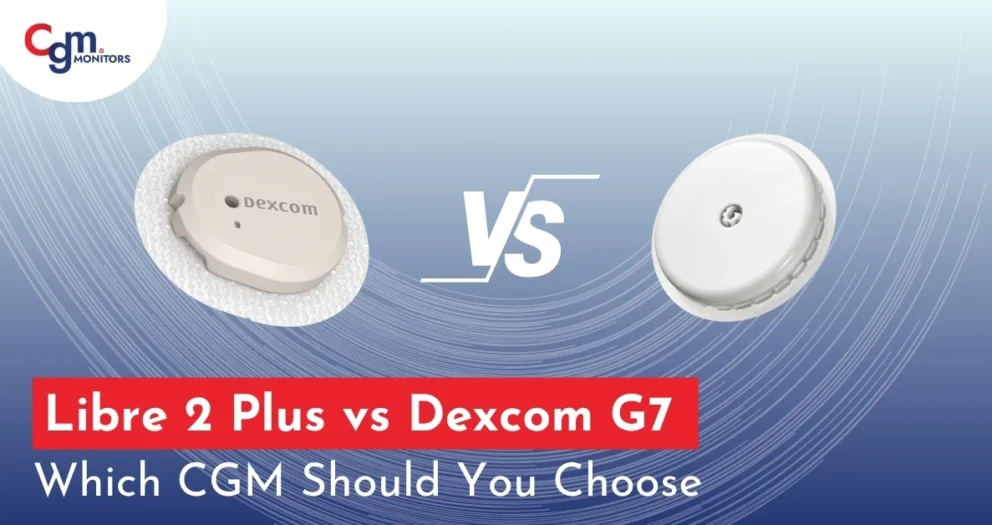The pain of injections just for consuming insulin has been replaced by the ease of automatic insulin delivery (AID) systems. Commonly known as insulin pumps, these insulin management devices are available for both type 1 and type 2 diabetics who are on insulin. However, specifically for type 1 diabetics, these pumps are a blessing, since they can communicate with your continuous glucose monitors (CGMs). These devices significantly reduce the risk of adverse hyperglycemic events. Not only that, but depending on the glucose readings from CGM sensors, these insulin pumps can stop insulin delivery as well. Let’s dive in to see some insulin pumps for type 1 diabetics.
Types of Insulin Pumps: Tube vs Tubeless Pumps
The insulin pumps are mainly divided into two categories, which are as follows:
Tubeless Pumps for Type 1 and Type 2
Although such pumps provide less control compared to the tubed pumps and may hold less insulin capacity, a tubeless insulin pump can add true ease to your diabetes management, with no tubing stress whatsoever:
1. Omnipod 5 Pod (by Insulet Corporation)
This automatic insulin delivery system has been indicated for both type 1 and type 2 diabetes. For type 1 diabetics aged 2 years and above, it is suitable. For type 2 diabetics, the minimum age to use the system is 18 years. This insulin pump is compatible with Dexcom G6, G7, and Freestyle Libre 2 Plus sensors. More details are as follows:
- Holds up to 200 units of rapid-acting insulin (U100), lasting up to 72 h (3 days).
- Waterproof wearable “Pod” adhered to the body (no tubing). Only the pod is waterproof and not the controller.
- For automatic control, this system offers SmartAdjust™ algorithm; automatic insulin delivery adjustments every ~5 minutes based on compatible CGM.
- Basal correction / insulin suspension/adjustment: Automatically increases, decreases or pauses insulin delivery based on CGM sensor values every 5 minutes.
- Average cost in USA: Exact pump cost varies; many insurance plans cover.
CGM Monitors offers flexible buying options. You can either get a free benefits check with us or simply buy an OmniPod 5 using your card at $749.00 (prices are subject to change; check out our product page).
Tubed Inulin Pumps for Type 1 Diabetics
They come with a pump machine, tube (available in different sizes), and infusion sets. While the insulin holding capacity varies between different pumps, these devices can usually hold more insulin compared to the tubeless pumps.
While these pumps come with a bit of tubing hassle, they provide more control over your insulin delivery. The following are some of the AID systems for type 1 diabetics:
1. MiniMed 780G (by Medtronic)
This tubed insulin pump has been indicated for type 1 diabetics aged 7 and above. It may also be used for type 2 diabetics who are aged 18 and above. The MiniMed 780G, according to the Medtronic site, works with the Simplera Sync™ sensor, Guardian™ 4 sensor, and Instinct sensor. The following are more details.
- Each reservoir holds up to 300 units of insulin (standard size).
- Waterproof up to 12 ft (3.6 m) for 24 hours when parts are correctly connected.
- Has SmartGuard™ technology (advanced hybrid closed loop) — automatically adjusts basal insulin and can also give automatic correction boluses every 5 minutes to help stay near target.
- Adjusts background insulin automatically; can give correction doses if glucose is rising; and can pause insulin if glucose goes too low or is predicted to.
Average cost (U.S.):
Exact out-of-pocket cost varies by insurance; Medtronic says most plans cover it, but prices aren’t listed.
2. t:slim X2 with Basal-IQ / Control-IQ (by Tandem Diabetes Care)
The tubed insulin pump is indicated for persons with diabetes requiring insulin therapy (pump and algorithm approved for use in persons aged 2 years and older for type 1 diabetes) and for type 2 diabetics aged 18 years and older when using the Control-IQ+ algorithm. It works with compatible CGM sensors, including the Dexcom G6 and G7 and the FreeStyle Libre 2 Plus sensors.
- Tubed infusion set (traditional pump).
- Bolus capacity/reservoir size: The cartridge holds up to 300 units U-100 insulin (3 mL).
- Water resistance: Not always specified as waterproof like some others; check latest spec sheet with vendor.
- Algorithm:
– Basal-IQ: Predictive low glucose suspend: Uses CGM values to suspend insulin if low predicted.
– Control-IQ: Hybrid closed-loop: predicts glucose 30 minutes ahead, adjusts basal, can deliver automatic correction bolus once per hour. - Basal correction / insulin suspension/adjustment:
– Basal-IQ: If CGM predicts < 80 mg/dL, suspend insulin.
– Control-IQ: If predicted > 180 mg/dL, gives correction bolus; adjusts basal up/down.
• Average cost in USA: Specific list price not public; contact CGM Monitors for current insurance/coverage and out-of-pocket estimate.
3. iLet Bionic Pancreas (by Beta Bionics)
The iLet Bionic Pancreas is an automated insulin delivery system for people with type 1 diabetes aged 6 years and older. Its algorithm only requires the user’s weight to initialise—no preset basal rates, correction factors or carb ratios are needed—and then it manages basal, bolus (meal) and correction dosing automatically.
Compatible CGM sensors include Dexcom G7 and the FreeStyle Libre 3 Plus. The system is designed to reduce burden on the user by automating more of the dosing decisions, requiring only meal-announcements (“Usual / More / Less”) rather than detailed carb counting.
- Tubed infusion (currently) system (though future versions aim for bi-hormonal, etc).
- Bolus capacity / reservoir size: Specification for reservoir not always clearly stated in public sources; typical reservoirs ~300 units in comparable pumps.
- Water resistance: Not clearly emphasised as waterproof in publicly available sources (check manufacturer).
- Algorithm: Fully automated insulin dosing system: requires only the person’s weight as input, then runs three algorithms (basal controller, bolus correction controller, meal announcement controller).
- Basal correction / insulin suspension/adjustment: The system administers insulin automatically without the need for manual basal rates, carb counting or correction factor inputs (once configured).
- Compatibility with CGM sensors: Works with Dexcom CGM or FreeStyle Libre 3 Plus sensor.
- Average cost in USA: As this is newer, cost varies. Contact CGM Monitors for latest info, coverage and reimbursement details.
- Notes for CGM Monitors: Ideal for patients seeking maximum automation, minimal manual adjustments, and who are comfortable with newer/progressive tech.

Conclusion
There are various insulin pump options available for type 1 diabetics in the US market. You should be selecting the one that best suits your requirements. People who require high control may find it useful to opt for tubed insulin pumps, while those looking only to add more ease to their diabetes management may go for the tubeless option, especially those who have active lifestyles.
Disclaimer: This blog is for informational purposes only and does not constitute medical, legal, or professional advice. While we strive for accuracy, errors or omissions may occur.
Some images in this blog may be AI-generated or for illustrative purposes only. Device images belong to their respective manufacturers and are used here for reference. Actual products may vary.
Frequently Asked Questions
What is an insulin pump and how does it work for Type 1 diabetes?
An insulin pump is a small device that delivers insulin throughout the day, just like a healthy pancreas would. Instead of taking multiple injections daily, the pump gives you steady background insulin and extra doses when you eat.
Who qualifies for an insulin pump?
You may qualify if you have Type 1 diabetes and struggle to maintain stable blood sugar levels with injections. Doctors also recommend pumps for people who experience frequent highs, lows, or want more flexibility in daily life.
Is an insulin pump better than insulin injections (MDI)?
For many people, pumps offer more control and convenience because dosing can be adjusted more precisely. However, the “best” choice depends on your lifestyle, comfort level, and how active your diabetes management routine is.
What is the cost of an insulin pump for Type 1 diabetes?
Insulin pumps can range widely in price, usually from a few hundred to several thousand dollars depending on the brand and model like freestyle libre 3 plus in just 110 and Dexcom G7 in 189 dollars. There are also ongoing supply costs like infusion sets and cartridges to consider.
What is the best insulin pump for Type 1 diabetics?
The “best” pump depends on your personal needs — some people prefer tubeless options like Omnipod, while others like Tandem (T: Slim X2) or Medtronic (Med 780 G) for advanced automation. Comfort, features, and budget play a big role in choosing the right one.
What are the downsides or risks of using an insulin pump?
Pumps require regular site changes and monitoring to avoid blockages or malfunctions. Some users also find wearing a device 24/7 to be an adjustment, especially during sleep, sports, or daily activities.
Do insulin pumps improve A1C and blood sugar control?
Many people see smoother blood sugar patterns and fewer highs and lows after switching to a pump. The real benefit comes from more precise insulin delivery and easier adjustments during meals and activity.
Can children and teenagers use insulin pumps?
Yes, pumps are widely used by kids and teens — especially because they allow more flexibility with eating, sports, and school activities. Families and care teams help manage settings as the child grows and routines change.







Write a comment
Your email address will not be published. All fields are required